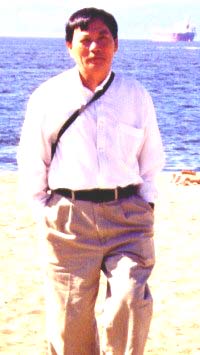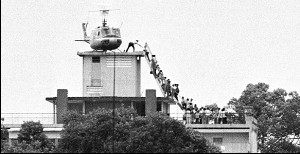 |
Hongkong,
29 tháng Tư, 2005. Ba mươi
năm trước tôi thật
may khi chụp được tấm hình ghi lại cảnh tượng Sài Gòn rơi vào tay VC
trong lúc
trực thăng Mỹ bốc người từ mái tòa Đại Sứ Hoa Kỳ. Nhưng, như rất nhiều
điều về
cuộc chiến VN, chuyện tưởng vậy mà không phải vậy. Nói rõ hơn, bức hình
không
chụp từ trên mái Tòa Đại Sứ, mà từ mái một building, ở trung tâm Sài
Gòn, nơi
đám đầu sỏ CIA trú ngụ. Đó là
ngày Thứ Ba, 29 Tháng
Tư, 1975. Tin đồn về chuyến di tản chót ra khỏi Sài Gòn thì đã có từ
mấy tuần
lễ trước. Hàng ngàn người, người Mỹ dân sự, người Việt, và người thuộc
các nước
thứ ba, sẽ được máy bay chở hàngb hoá bốc đi tại sân bay Tân Sơn Nhất,
và sẽ
hướng tới những căn cứ của Mỹ như ở Guam, Okinawa, hay đâu đó. Mọi
người đều
biết quân đội Bắc Việt đang xiết vòng vây quanh thành phố, và việc thất
thủ chỉ
còn là ngày một ngày hai. Vào khoảng 11 giờ sáng, một cú điện thoại từ
Brian
Ellis, trưởng phòng CBS, người lo việc phối hợp trong công tác di tản
đám báo
chí ngoại quốc. Lên đường! Điểm tụ
tập là trên đường Gia
Long, đối diện nhà thương Grall, xe buýt sẽ bốc người từ đó. Mật hiệu
di tản là
trên Đài Phát Thanh Quân Đội Mẽo là một mẩu tin thời tiết, “thời tiết
lúc này
là 105 độ và còn tăng”, tiếp theo là tám nốt nhạc, bài Giáng Sinh Trắng, Đừng
hỏi thằng ngu nào nghĩ
ra một mật hiệu như thế. Chẳng có gì là bí mật tại thành phố Sài Gòn
vào những
ngày như thế này, và bất cứ người Việt nào, ngay cả con chó của người
đó, cũng
biết, đây là một mật hiệu. Thirty
Years at 300
Millimeters by
Hubert Van Es Published
April 29, 2005 Copyright
2005 - The New York
Times Company PRINTED
WITH THE CONSENT OF
THE NEW YORK TIMES HONG KONG - Thirty years ago I was fortunate
enough to take a photograph that has become perhaps the most
recognizable image
of the fall of It was Tuesday, April 29, 1975. Rumors about
the final evacuation of Saigon had been rife for weeks, with thousands
of
people -- American civilians, Vietnamese citizens and third-country
nationals
-- being loaded on transport planes at Tan Son Nhut air base, to be
flown to The assembly point was on Gia Long Street,
opposite the The
journalists who had
decided to leave went to the assembly point, each carrying only a small
carry-on bag, as instructed. But the Vietnamese seeing this exodus were
quick
to figure out what was happening, and dozens showed up to try to board
the
buses. It took quite a while for the vehicles to show -- they were
being driven
by fully armed Marines, who were not very familiar with I
wasn't on them. I had
decided, along with several colleagues at United Press International,
to stay
as long as possible. As a Dutch citizen, I was probably taking less of
a risk
than the others. They included our bureau chief, Al Dawson; Paul Vogle,
a
terrific reporter who spoke fluent Vietnamese; Leon Daniel, an affable
Southerner; and a freelancer working for U.P.I. named Chad Huntley. I
was the
only photographer left, but luckily we had a bunch of Vietnamese
stringers, who
kept bringing in pictures from all over the city. These guys were
remarkable.
They had turned down all offers to be evacuated and decided to see the
end of
the war that had overturned their lives. On the
way back from the
evacuation point, where I had gotten some great shots of a Marine
confronting a
Vietnamese mother and her little boy, I photographed many panicking
Vietnamese
in the streets burning papers that could identify them as having had
ties to
the Returning to the office, which was on the top floor of the rather grandly named Peninsula Hotel, I started processing, editing and printing my pictures from that morning, as well as the film from our stringers. Our regular darkroom technician had decided to return to the family farm in the countryside. Two more U.P.I. staffers, Bert Okuley and Ken Englade, were still at the bureau. They had decided to skip the morning evacuation and try their luck in the early evening at the United States Embassy, where big Chinook helicopters were lifting evacuees off the roof to waiting Navy ships off the coast. (Both made it out that evening.) If you
looked north from the
office balcony, toward the cathedral, about four blocks from us, on the
corner
of Tu Do and Gia Long, you could see a building called the Pittman
Apartments,
where we knew the C.I.A. station chief and many of his officers lived.
Several
weeks earlier the roof of the elevator shaft had been reinforced with
steel
plate so that it would be able to take the weight of a helicopter. A
makeshift
wooden ladder now ran from the lower roof to the top of the shaft.
Around 2:30
in the afternoon, while I was working in the darkroom, I suddenly heard
Bert
Okuley shout, ''Van Es, get out here, there's a chopper on that roof!'' I grabbed my camera and the longest lens left
in the office -- it was only 300 millimeters, but it would have to do
-- and
dashed to the balcony. Looking at the Pittman Apartments, I could see
20 or 30
people on the roof, climbing the ladder to an Air America Huey
helicopter. At
the top of the ladder stood an American in civilian clothes, pulling
people up
and shoving them inside. Of course, there was no possibility that all
the people on the roof could get into the helicopter, and it took off
with 12
or 14 on board. (The recommended maximum for that model was eight.)
Those left
on the roof waited for hours, hoping for more helicopters to arrive. To
no
avail. After
shooting about 10
frames, I went back to the darkroom to process the film and get a print
ready
for the regular 5 p.m. transmission to And
this is where the
confusion began. For the caption, I wrote very clearly that the
helicopter was
taking evacuees off the roof of a downtown Later
that afternoon, five
Vietnamese civilians came into my office looking distraught and afraid.
They
had been on the Pittman roof when the chopper had landed, but were
unable to
get a seat. They asked for our help in getting out; they had worked in
the
offices of the United States Agency for International Development, and
were
afraid that this connection might harm them when the city fell to the
Communists. One of them had a two-way radio that could
connect to the embassy, and Chad Huntley managed to reach somebody
there. He
asked for a helicopter to land on the roof of our hotel to pick them
up, but
was told it was impossible. Al Dawson put them up for the night,
because by
then a curfew was in place; we heard sporadic shooting in the streets,
as
looters ransacked buildings evacuated by the Americans. All through the
night
the big Chinooks landed and took off from the embassy, each accompanied
by two
Cobra gunships in case they took ground fire. After a restless night, our photo stringers
started coming back with film they had shot during the late afternoon
of the
29th and that morning -- the 30th. Nguyen Van Tam, our radio-photo
operator,
went back and forth between our bureau and the telegraph office to send
the
pictures out to the world. I printed the last batch around 11 a.m. and
put them
in order of importance for him to transmit. The last was a shot of the
six-story chancery, next to the embassy, burning after being looted
during the
night. About 12:15 Mr. Tam called me and with a
trembling voice told me that that North Vietnamese troops were
downstairs at
the radio office. I told him to keep transmitting until they pulled the
plug,
which they did some five minutes later. The last photo sent from The war was over. I went out into the streets to photograph the
self-proclaimed liberators. We had been assured by the North Vietnamese
delegates, who had been giving Saturday morning briefings to the
foreign press
out at the airport, that their troops had been told to expect
foreigners with
cameras and not to harm them. But just to make sure they wouldn't take
me for
an American, I wore, on my camouflage hat, a small plastic Dutch flag
printed
with the words ''Boa Chi Hoa Lan'' (''Dutch Press''). The soldiers,
most of
them quite young, were remarkably friendly and happy to pose for
pictures. It
was a weird feeling to come face to face with the ''enemy,'' and I
imagine that
was how they felt too. I left Saigon on June 1, by plane for It was 15 years before I returned. My absence
was not for a lack of desire, but for the repeated rejections of my
visa
applications by an official at the press department of the Foreign
Ministry. It
turned out that I had a history with this man; he had come to our
office about
a week after Saigon fell because, as the editor of one of He obviously had a long memory, and I assume
it was only after he retired or died that my actions were forgiven and
I was
given a visa. I have since returned many times from my home in Hong
Kong,
including for the 20th and 25th anniversaries of the fall, at which
many old © Hubert Van Es Discuss
Thirty Years at 300
Millimeters in the forums Hubert Van Es, a freelance photographer,
covered the Vietnam War, the Moro Rebellion in the |
